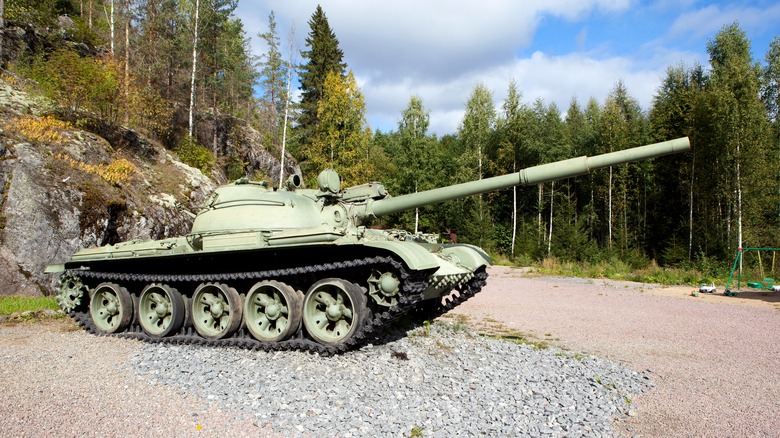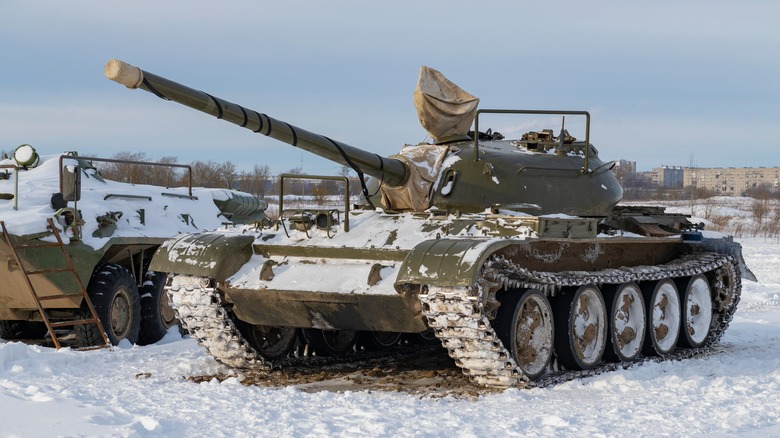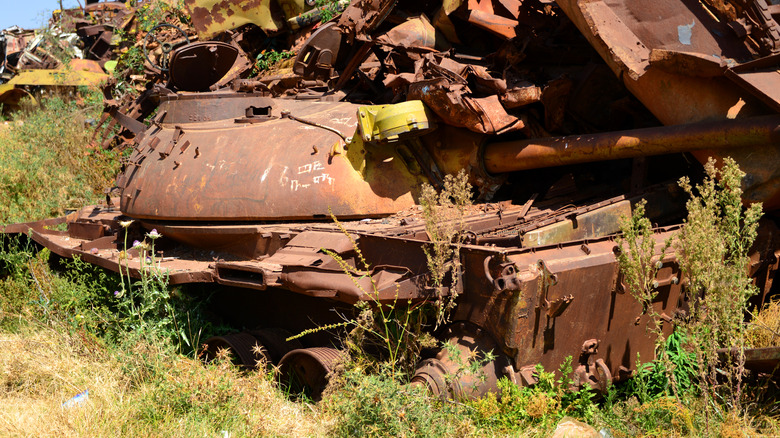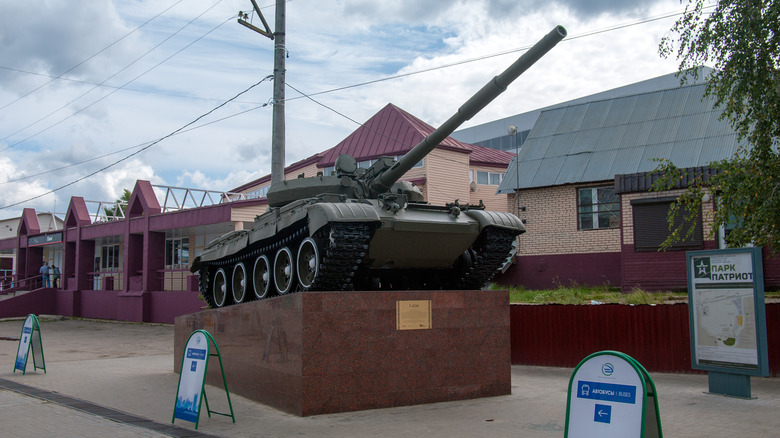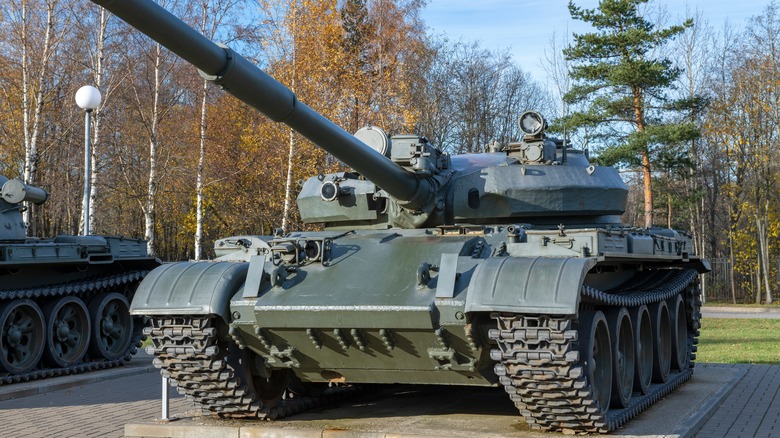Everything To Know About The T-62 Battle Tank
World War II era experimentations with the likes of the huge Panzer VIII Maus, a 188-ton monstrosity that never made it past the prototype stage, made one thing quite clear: There's historically been a fine line between heavy tanks and too-heavy tanks. Entering the Cold War era, the militaries of the world seemed to reach the consensus that it was more practical to blend the armor of a heavy tank with the maneuverability and utility of medium tanks.
The main battle tank, as these new models came to be known, was something of a transitional breed in its first iterations. The Soviet Union, always quite keen to unleash new types of tanks, was at the forefront of this development. One of the earliest Soviet main battle tanks was the T-62, a model of great potential and considerable firepower that was based upon the frame of the earlier T-55.
In this piece, we'll investigate the origins and development of this tank, the technical specs and arsenal it boasted, the role it's played since its introduction, and the variants introduced and models that followed in its wake.
A new breed of main battle tank
The T-62 has roots in the end of World War II, with the T-54 and T-55 (pictured above). The first T-54 was created in March of 1945, around six months before the conclusion of the war. This family of tanks would go on to serve as a potent weapon for a new era of global conflict.
As is so often the case with the development of military vehicles, the T-54 was built from an existing framework, a combination of old technology and the new. In this case, the body was adapted from that of the T-44, which itself had innovations for Soviet tanks incorporated into its design. These included a new and less intrusive position for the engine, affording occupants more room (which hadn't historically been a major concern with Soviet tanks), and reinforcement and protection of the entry hatch.
Just as the T-44 was developed to improve upon the T-34, the T-54 was an advancement of the T-44's capabilities. Its water-cooled diesel V-12 offered 500 horsepower (upped to 580 hp with the 1955 upgraded T-55), and with a 100mm anti-tank gun and 9M117 Bastion missiles, it was truly a main battle tank developed to bring the fight to its rival machines.
1961's T-62 had huge shoes to fill — its predecessors went on to become the most prolific models in history, with up to 100,000 T-54s and 55s being built. Its specs marked yet more new ground, however.
The specs, equipment, and weaponry of the T-62
As with the T-55 of 1955, the T-62 engine boasts 580 hp, a formidable diesel powerplant in the form of a V55-5 V-12. Reasonably maneuverable, it is equipped with a quintet of wheels and is capable of speeds around 31 mph. Snorkel apparatus also enabled more tactical versatility and maneuverability, though it had a limited capacity to pass through water. With armor as thick as 242mm at the gun and as thin as 30mm above it, it has its notable vulnerabilities, as most models tend to do.
The T-62, in an attempt to somewhat offset this, is resistant to a traditional weakness of tanks: mines concealed in the ground to target a less heavily armored underbelly. It's fitted with a KMT-5 system at the front for dispatching mines before they pose a danger to it.
The base model of the tank is equipped with a 7.62mm machine gun for supportive fire alongside a potent primary weapon: a smoothbore 115 mm gun. It was, in short, a large iterative improvement on the tank family in terms of its specs. As would be expected of such a widely-used series of vehicles, it was also further improved in various ways by a series of new models developed as time went on.
The new capabilities of other T-62 models
Sometimes, improved versions of vehicle models can take a very long time to develop. In other cases, the process can be surprisingly fast. Over its production lifetime and beyond, both happened with the T-62. The year after its introduction, a variant was released that made technical modifications to the interior and engine's placement.
More significant changes to armaments would take rather longer to materialize: It wasn't until 1972 that the T-62A arrived, bringing with it a new 12.7-mm DShKM. This is not only a larger gun but one that provides an option to help combat opposing aircraft. It certainly wasn't to be relied upon to provide such, but it's an invaluable option for any tank to have in its arsenal. Such machines are far from optimized for combat against non-ground targets, after all. Later, the TO-62, equipped with a highly intimidating flamethrower, would be added to the roster, while the T-62M features a Sheksna 9K116-2 equipped with deadly missiles.
In terms of defensive additions, the T-62D features the Drozd, an active defense system first used in 1983 that is somewhat akin to the later Trophy system. Elsewhere in the world, the base T-62 was further adapted for more specific roles.
The varied uses of the T-62 in its many guises
The T-62 is primarily known as a main battle tank. It continued to be used in that role for a long time, fielded by Russia until the late 2000s. Even then, the models were not disposed of but stored as reserves. In October 2023, Forbes reported that the invasion of Ukraine resulted in some of these tanks returning to combat, having been festooned in rather makeshift armor in the hopes of repelling drones (a threat the T-62s didn't face when they were new).
Ukraine, meanwhile, wielded a customized version dubbed the KMDB T-62. Another nation that has made use of it is Bulgaria, which modified it into the TV-62M ARV, as well as the TP-62, a fascinating machine developed by Terem–Khan Krum Ltd for putting out fires. "In addition to water-throwers, the [TP-62] is also equipped with a rake and plow, allowing it to contain wildfires by digging and plowing," Novinite.com reported in July 2012, as a prototype model was tasked with helping to contain the wildfires in Vitosha.
The legacy of the T-62, then, is quite impressive, taking the machine in directions its original developers surely couldn't have envisaged.
